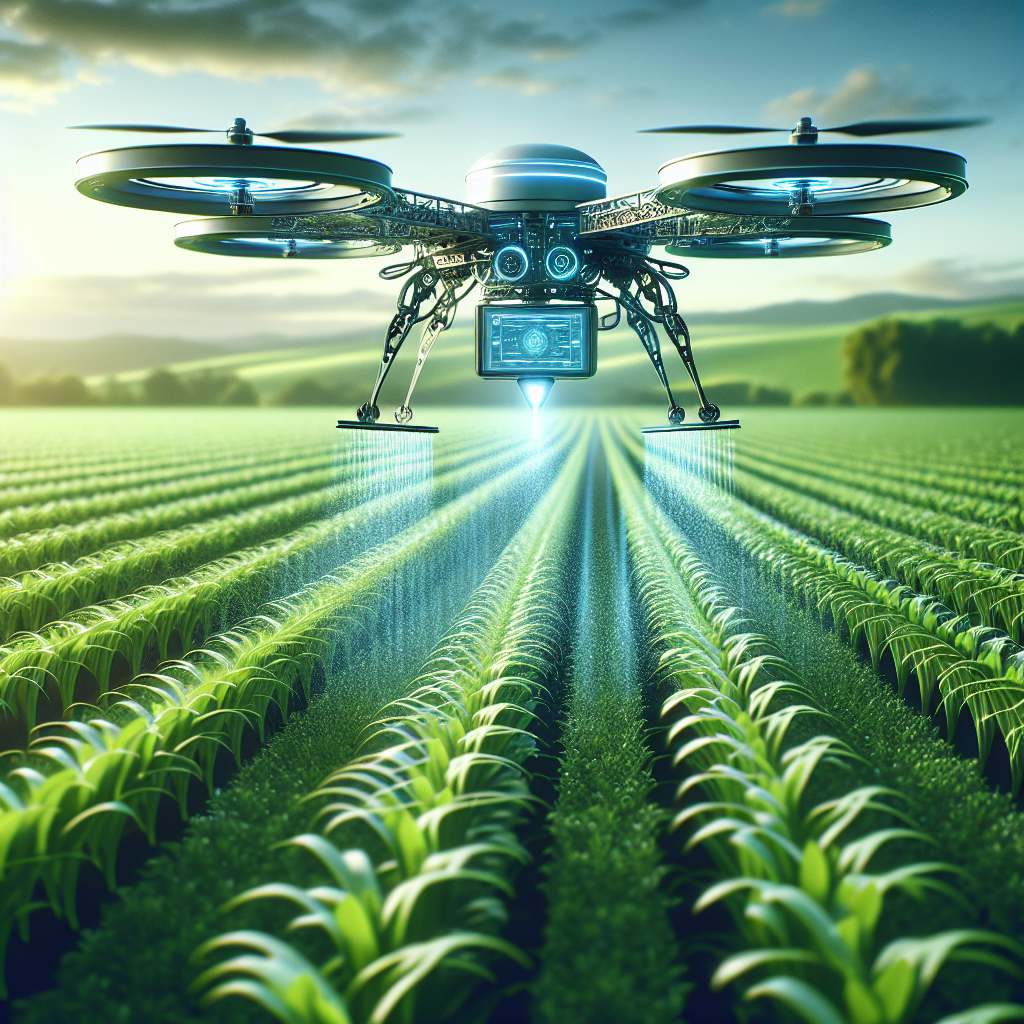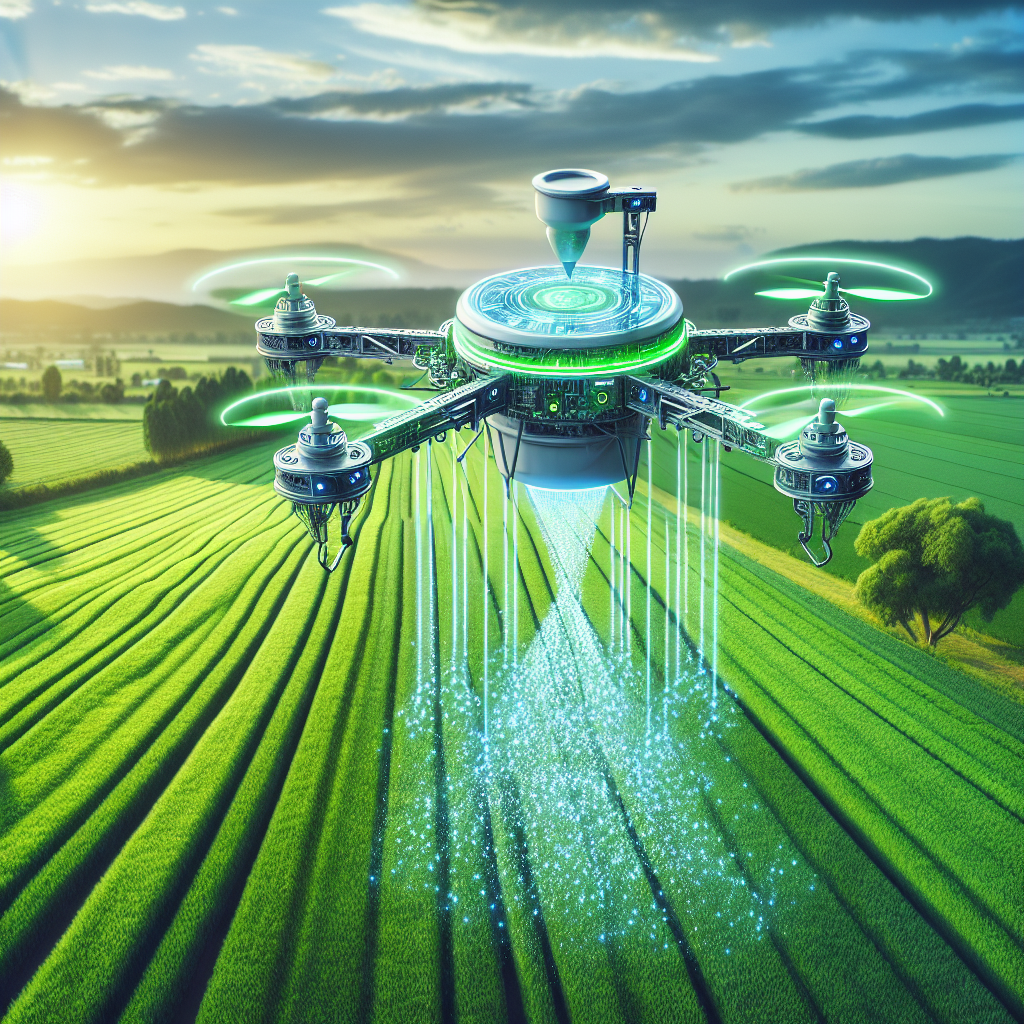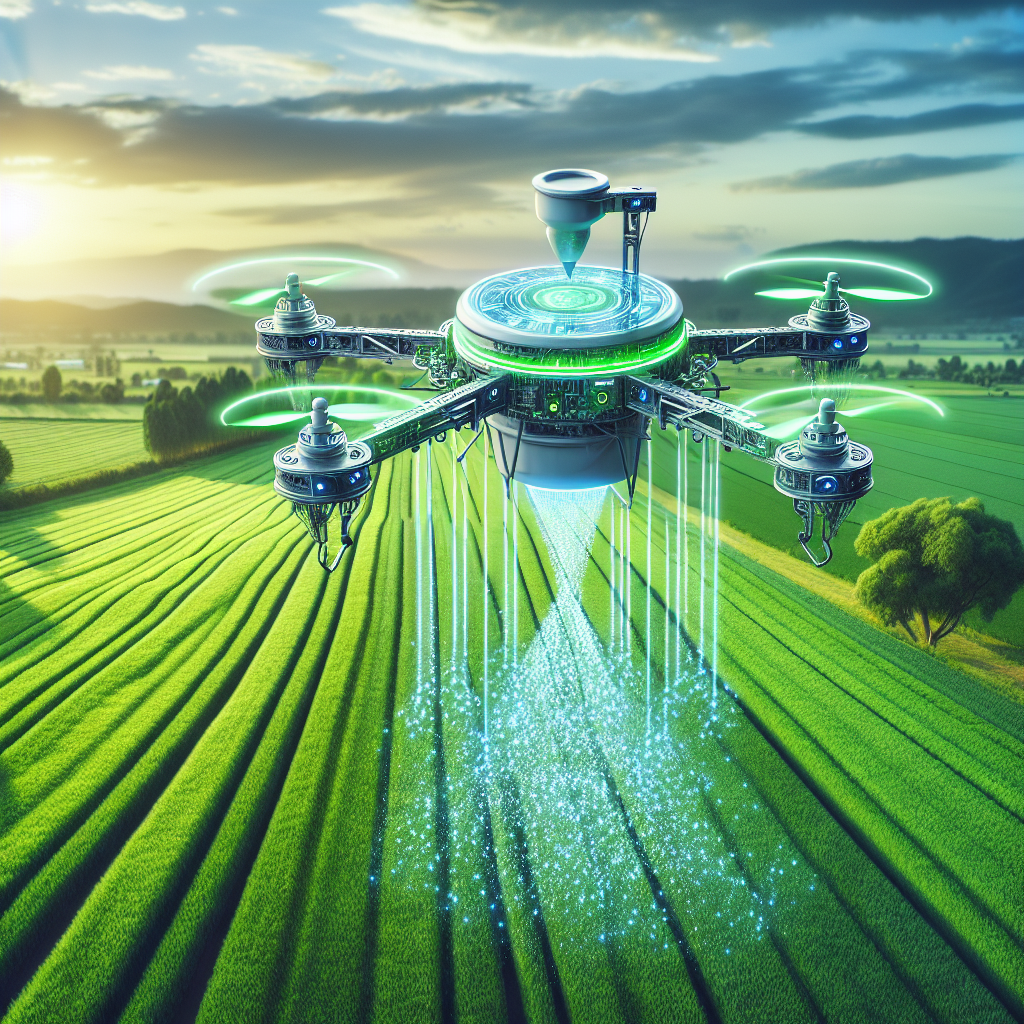AI, or artificial intelligence, has become increasingly prevalent in various industries, including agriculture. In this article, we will explore the fascinating world of AI and its applications within the agricultural sector. From precision farming to crop monitoring and even robotic assistance, AI technology is revolutionizing how farmers approach their work. Let’s delve into the ways AI is transforming agriculture and learn about the incredible advancements being made in this field.

Improving Crop Yield
Crop Monitoring
Crop monitoring is an essential aspect of modern agriculture, and AI technology can greatly enhance the efficiency and accuracy of this process. By utilizing satellite imagery and other remote sensing techniques, AI algorithms can analyze vast amounts of data to monitor crop growth, detect irregularities, and identify potential issues such as nutrient deficiencies or water stress. This real-time monitoring allows farmers to make timely interventions, adjust their farming practices, and maximize crop yield.
Crop Disease Detection
Detecting crop diseases at an early stage is crucial for preventing significant yield losses and minimizing the use of chemical treatments. AI-powered systems can analyze vast amounts of data, including images of plants and leaves, to identify disease symptoms accurately. Machine learning algorithms can learn from a large database of annotated images to differentiate between healthy and diseased plants, allowing farmers to take immediate actions and prevent the spread of diseases.
Precision Irrigation
Water scarcity is a serious concern in agriculture, and precision irrigation techniques can play a significant role in conserving water resources while ensuring optimal crop growth. AI-powered systems can analyze various data inputs, such as weather conditions, soil moisture levels, and crop water requirements, to determine the precise amount of water needed for irrigation. By using these insights, farmers can avoid over-irrigation, reduce water waste, and ensure that each plant receives the right amount of water it needs for healthy growth.
Enhancing Livestock Management
Animal Monitoring
AI technology can revolutionize livestock management by enabling real-time monitoring of individual animals. Sensors attached to animals can collect data on their health, behavior, and location, providing valuable insights into their overall well-being. AI algorithms can analyze this data, detect any unusual patterns or signs of distress, and alert farmers to potential health issues. Continuous monitoring allows farmers to take proactive measures, such as providing timely veterinary care or adjusting feed and nutrition plans, thus improving animal welfare and productivity.
Health Tracking
Ensuring the health of livestock is crucial for maintaining high productivity and avoiding the spread of diseases. AI-powered systems can analyze data collected from wearable devices, such as smart collars or ear tags, to track vital signs and detect any deviations from normal patterns. Advanced algorithms can identify health issues at an early stage, enabling farmers to take immediate action and prevent the further spread of diseases. This proactive approach not only benefits individual animals but also helps safeguard the overall health of the entire herd.
Feed Optimization
Proper nutrition is essential for the growth and development of livestock. AI algorithms can analyze a wide range of data, including animal weight, growth rates, and nutritional requirements, to optimize the formulation of animal feed. By considering various factors such as ingredient availability, cost, and nutrient composition, AI-based systems can develop precise feeding plans that meet the specific needs of each animal. This personalized approach to feed optimization ensures that livestock receives the optimal nutrition, promoting their health and maximizing productivity.
Automating Agricultural Machinery
Robotic Harvesting
AI technology is transforming the harvesting process by automating the labor-intensive task of picking crops. Advanced robotics systems equipped with AI algorithms can identify ripe fruits or vegetables, determine the optimal harvesting technique, and precisely pick and sort the produce. Robotic harvesters work tirelessly and quickly, significantly reducing the time and labor required for harvesting. This automation also improves efficiency, reduces product waste, and ensures that crops are harvested at optimal ripeness, enhancing overall yield and quality.
Autonomous Tractors
Autonomous tractors equipped with AI-powered navigation systems and sensors are revolutionizing the field of precision farming. By utilizing GPS technology and advanced computer vision, these tractors can navigate fields with high precision, minimize overlap, and precisely apply fertilizer, pesticides, or herbicides in the right areas. This targeted application reduces chemical usage, minimizes environmental impact, and optimizes resource allocation, leading to improved crop health and better yields.
Weeding and Pest Control
AI technology is revolutionizing the way farmers manage weeds and control pests. With the help of computer vision and machine learning algorithms, autonomous machines can distinguish between crops and weeds, enabling precise and targeted weed control. Similarly, AI-powered pest detection systems can identify specific pests, such as insects or diseases, through image analysis. By accurately detecting and treating weeds and pests, farmers can minimize crop damage, reduce the use of chemical pesticides, and optimize crop yield.
Optimizing Supply Chain
Demand Forecasting
Accurate demand forecasting plays a vital role in optimizing the agricultural supply chain and ensuring that the right quantity of products is available at the right time. AI algorithms can analyze historical data, market trends, and other relevant factors to predict future demand accurately. This enables farmers and suppliers to plan their production, inventory, and distribution processes efficiently, reducing the risk of overstocking or shortages. By optimizing the supply chain based on accurate demand forecasts, agricultural businesses can minimize waste, increase profitability, and meet customer expectations.
Inventory Management
Efficient inventory management is crucial for minimizing waste, avoiding excess stock, and ensuring timely deliveries. AI-powered systems can analyze various data inputs, such as sales data, production rates, and shelf-life information, to optimize inventory levels. By predicting demand patterns, detecting trends, and considering external factors, AI algorithms can enable accurate inventory forecasting and reduce the risk of stockouts or overstocking. This data-driven approach to inventory management helps farmers and suppliers optimize their resources, increase efficiency, and improve overall profitability.
Logistics Optimization
Effective logistics management is essential for streamlining the transportation of agricultural products from farms to consumers. AI algorithms can analyze various data inputs, including traffic conditions, weather forecasts, and delivery schedules, to optimize routes, minimize transportation costs, and ensure timely deliveries. By optimizing logistics operations, farmers can reduce energy consumption, decrease carbon emissions, and enhance customer satisfaction by improving the reliability and efficiency of product distribution.

Improving Soil Health and Management
Soil Monitoring and Analysis
Maintaining healthy soil is crucial for sustainable crop growth and overall agricultural productivity. AI-powered systems can analyze data collected from soil sensors, such as moisture levels, pH levels, and nutrient content, to monitor soil health. By combining this data with weather information, crop data, and historical trends, AI algorithms can provide insights into soil conditions and recommend appropriate soil management practices. This proactive approach to soil monitoring and analysis helps farmers maintain optimal soil health, enhance nutrient availability, and improve crop yield.
Nutrient Management
Proper nutrient management is key to maximizing crop yield and preventing nutrient deficiencies or excesses. AI algorithms can analyze soil and plant data, historical yield records, and nutrient requirements to develop personalized nutrient management plans. By considering factors such as soil type, crop type, and environmental conditions, AI-powered systems can recommend the right amount and type of fertilizers to apply, ensuring efficient nutrient uptake and promoting healthy plant growth. This optimized approach to nutrient management minimizes waste, reduces environmental impact, and improves overall crop productivity.
Soil Erosion Prediction
Soil erosion is a major challenge in agriculture, leading to loss of topsoil, reduced fertility, and increased runoff. AI-powered systems can analyze various data inputs, including weather patterns, terrain characteristics, and historical erosion rates, to predict areas at risk of soil erosion. By identifying vulnerable locations, farmers can implement erosion control measures, such as contour plowing or planting cover crops, to minimize soil loss. This predictive approach enables proactive soil erosion management, protects valuable soil resources, and ensures sustainable agricultural practices.
Enhancing Pest and Disease Management
Early Pest Detection
Early detection of pests is critical for preventing significant crop damage and reducing reliance on chemical pesticides. AI-powered pest detection systems can analyze data from various sources, such as images, weather conditions, and historical pest records, to identify the presence of pests early on. By continuously monitoring fields and alerting farmers to the presence of pests, AI algorithms enable prompt intervention and targeted pest control strategies. This proactive approach minimizes crop losses, reduces pesticide use, and promotes ecological balance in agricultural ecosystems.
Predictive Disease Outbreaks
Predicting disease outbreaks is essential for preventing the spread of diseases and minimizing their impact on crop yield. AI algorithms can analyze real-time data, such as weather conditions, crop health records, and disease prevalence, to forecast the likelihood of disease outbreaks. By identifying high-risk areas or crops, farmers can implement preventive measures, such as adjusting irrigation or applying fungicides, to mitigate the risk of disease spread. This predictive approach to disease management enables farmers to take timely actions, protect crops from diseases, and ensure optimal yield and quality.
Targeted Intervention
AI technology enables targeted intervention strategies to control pests and diseases effectively. By analyzing data on pest behavior, disease dynamics, and environmental factors, AI-powered systems can recommend precise and targeted interventions. This includes strategies such as applying biocontrol agents, using pheromone traps, or implementing cultural practices to disrupt pest lifecycles. By adopting targeted intervention measures, farmers can minimize chemical use, reduce environmental impact, and effectively manage pest and disease outbreaks, ensuring the health and productivity of their crops.
Facilitating Agricultural Research
Data Analysis
AI technology plays a crucial role in analyzing vast amounts of agricultural data to extract meaningful insights and facilitate scientific research. By applying machine learning algorithms to datasets from various sources, researchers can identify patterns, uncover correlations, and gain a deeper understanding of complex agricultural processes. This data-driven approach enhances research capabilities, accelerates scientific discoveries, and helps address pressing challenges such as climate change, food security, and sustainable agriculture.
Crop Breeding
AI-powered systems have the potential to revolutionize the field of crop breeding by accelerating the development of new varieties with desirable traits. By analyzing genetic data, crop performance records, and environmental factors, AI algorithms can identify genetic markers associated with desired traits and predict the performance of different breeding combinations. This enables researchers to select the most promising candidates for further breeding, reducing the time and resources required for developing new crop varieties. The use of AI in crop breeding expedites the development of more resilient, productive, and nutritionally enhanced crops, benefiting farmers and consumers alike.
Climate Change Modeling
Predicting and mitigating the impacts of climate change is a critical aspect of agricultural research. AI algorithms can analyze large datasets, including climate models, satellite imagery, and historical weather patterns, to develop accurate climate change models. These models can simulate future climate scenarios, predict the impacts on crop growth and yield, and help researchers devise appropriate adaptation strategies. By integrating AI technology into climate change research, scientists can enhance their understanding of complex climate processes and develop more effective strategies for climate-resilient agriculture.
Increasing Energy Efficiency
Smart Irrigation Systems
Smart irrigation systems powered by AI technology can optimize water usage and improve energy efficiency in agriculture. By integrating weather data, soil moisture sensors, and plant water requirements, AI algorithms can dynamically adjust irrigation schedules and volumes based on real-time conditions. This precise control of irrigation helps minimize water waste, reduce energy consumption associated with pumping and distribution, and ensure that crops receive optimal moisture levels for healthy growth. Smart irrigation systems enable farmers to conserve water resources, lower energy costs, and enhance sustainability in agriculture.
Energy Usage Optimization
AI technology can help farmers optimize energy usage in various agricultural operations, leading to reduced energy costs and environmental impact. By analyzing data on equipment performance, weather conditions, and energy consumption patterns, AI algorithms can identify opportunities for energy efficiency improvements. This includes optimizing machinery usage, scheduling operations during non-peak hours, and adopting energy-saving technologies. By harnessing AI technology for energy usage optimization, farmers can reduce their carbon footprint, increase operational efficiency, and achieve long-term sustainability in their farming practices.
Remote Monitoring
Remote monitoring powered by AI technology allows farmers to track energy consumption and identify areas for energy savings without physically being present on the farm. By leveraging sensor networks, smart meters, and AI algorithms, farmers can remotely monitor energy consumption patterns, identify anomalies, and detect equipment malfunctions or inefficiencies. This real-time monitoring enables timely intervention, maintenance, and optimization of energy usage, helping farmers reduce energy waste, lower operational costs, and improve the overall energy efficiency of their agricultural operations.
Improving Precision Farming
Satellite Imagery
Satellite imagery, combined with AI algorithms, is revolutionizing precision farming by providing valuable insights into crop health, growth patterns, and variability across fields. By analyzing satellite images, AI algorithms can identify crop stress, nutrient deficiencies, and disease outbreaks on a large scale. This information enables farmers to take targeted actions, such as adjusting irrigation or applying fertilizers, precisely where needed. Satellite imagery facilitates precision farming by providing farmers with accurate, up-to-date information on the condition of their crops, improving decision-making and maximizing crop yield.
GPS Field Mapping
GPS field mapping, when combined with AI technology, enables farmers to accurately map and analyze their fields for precision farming practices. By utilizing GPS technology and sensors, farmers can precisely capture field boundaries, topographic features, and soil characteristics. AI algorithms can then analyze this data to identify optimal planting patterns, determine variable rate application zones, and guide the placement of irrigation or drainage systems. GPS field mapping combined with AI facilitates precise and efficient resource allocation, minimizing inputs and maximizing the use of farm resources, resulting in improved crop yield and environmental sustainability.
Variable Rate Technology
Variable rate technology (VRT) allows farmers to apply inputs, such as fertilizers or pesticides, at different rates across their fields based on the specific needs of each area. AI-powered systems can analyze data on soil fertility, yield potential, and historical performance to determine the appropriate application rates for different zones within a field. This precision targeting ensures that crops receive the right amount of inputs, minimizing waste and optimizing crop growth. VRT, when integrated with AI technology, enables farmers to achieve cost savings, reduce environmental impact, and enhance overall performance in their farming operations.
Streamlining Data Collection and Analysis
Drones and UAVs
Drones and unmanned aerial vehicles (UAVs) equipped with sensors and cameras are transforming data collection in agriculture. These aerial devices can capture high-resolution images, multispectral data, and LiDAR scans, providing detailed information on crop health, topography, and vegetation density. AI algorithms can then analyze this data to generate actionable insights, such as detecting crop stress, identifying drainage issues, or monitoring vegetation growth. By streamlining data collection and analysis, drones and UAVs powered by AI technology enable farmers to make data-driven decisions, optimize farming practices, and enhance overall crop yield.
Sensor Networks
Sensor networks integrated with AI technology provide real-time data on various environmental factors, such as temperature, humidity, soil moisture, and pest activity. These sensors can be deployed across fields or inside greenhouses, continuously collecting data that is transmitted wirelessly to a central system. AI algorithms analyze this data and provide farmers with detailed information on environmental conditions, allowing for effective decision-making and proactive interventions. Sensor networks improve data accuracy, reduce the risk of human error, and enable precise monitoring and control of agricultural environments, leading to optimized crop yield and resource management.
Machine Learning Algorithms
Machine learning algorithms are at the core of AI technology in agriculture, enabling data analysis, pattern recognition, and predictive modeling. By training on large datasets, machine learning algorithms can identify patterns, learn from examples, and make predictions or recommendations based on the analyzed data. In agriculture, these algorithms can analyze data from various sources, such as satellite imagery, weather records, or historical crop yields, to provide valuable insights into crop growth, disease risk, or optimal farming practices. Machine learning algorithms empower farmers with actionable information, enabling them to make informed decisions, optimize resource allocation, and maximize crop yield.
